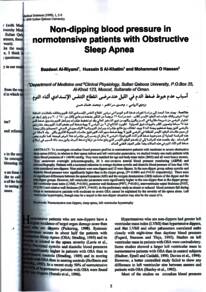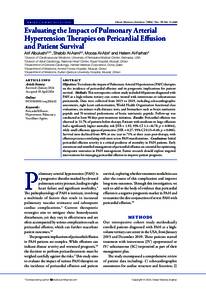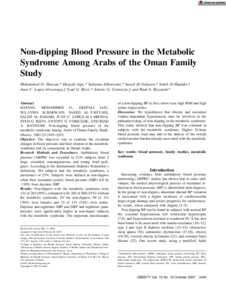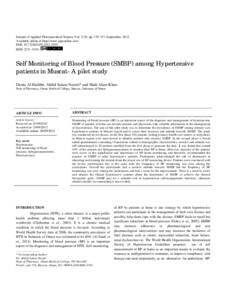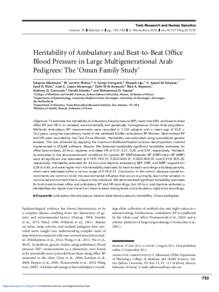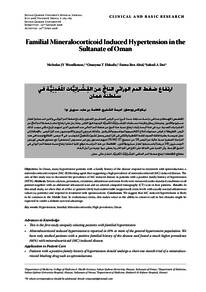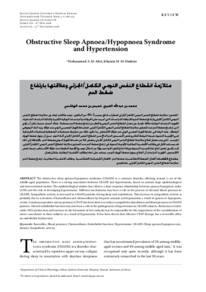وثيقة
Non-dipping blood pressure in normotensive patients with Obstructive Sleep Apnea
المساهمون
Sir Al-Khatim, Hussain., مؤلف
Hassan, Mohammad O., مؤلف
عناوين أخرى
أسباب عدم هبوط ضغط الدم في الليل عند مرضى انقطاع التنفس الإنسدادي أثناء النوم
الناشر
College of Medicine, Sultan Qaboos University.
ميلادي
1999-01
اللغة
الأنجليزية
الموضوع
الملخص الإنجليزي
To investigate circadian blood pressure profiles in normotensive patients with moderate te severe obstructive sleep apnea (OSA), in relatien te their apnea indices and left ventricular parameters, we studied twenty one male patients with clinic bleed pressures of 140/90 mmHg. They were matched for age and body mass index (BMI) and all were heavy snorers. They underwent overnight polysomnography, 24 h non-invasive arterial blood pressure monitoring (ABPM) and echocardiography. Patients with a nocturnal reductien in average daytime systolic and diastolic blood pressure of' less than 10% were considered non-dippers. Nine patients were non-clippers and 12 were clippers. In the non-dipper group asleep systolic and blood pressure were significantly higher than in the dipper group, (P< 0.0001 and P< 0.01 respectively), There were at significant differences between the apne of hypopnea (AHI) and the oxygen desaturatien (ODI) indices of the dipper and the non-dipper groups. However, left ventricular parameters were significantly higher in the non-dipper than in the dipper group: left ventricular mass index (LVMI, p< 0.001, posterier wall thickness (PWT, p< 0.00 1 ), interventricular septal thickness (IVST, P < 0.00 1 ) and relative wall thickness (RWT, P< 0.01). In this preliminary study an absent or reduced blood pressure fall during sleep in normotensive patients with moderate to severe 0SA cannot be explained by the severity of the apnea alone. Left ventricular hypertrephy, though may be a sequel te the non-dipper situation may also be the cause of it.
المجموعة
URL المصدر
الملخص العربي
للتحقيق في ملفات ضغط الدم اليومية في المرضى الذين يعانون من انقطاع النفس الانسدادي النومي المعتدل (OSA) ، في مؤشرات انقطاع النفس ومعلمات البطين الأيسر ، درسنا واحد وعشرين مريضًا من الذكور الذين يعانون من ضغوط نزيف العيادة 140/90 مم زئبق. تمت مطابقتهم من حيث العمر ومؤشر كتلة الجسم (BMI) وكانوا جميعًا يعانون من الشخير الثقيل. لقد خضعوا لتخطيط النوم الليلي ، ومراقبة ضغط الدم الشرياني غير الغازية لمدة 24 ساعة (ABPM) وتخطيط صدى القلب. المرضى الذين يعانون من انخفاض ليلي في متوسط ضغط الدم الانقباضي والانبساطي أثناء النهار أقل من 10٪ اعتبروا غير غطاسين. تسعة مرضى كانوا غير كليبرز و 12 كانوا كليبرز. في المجموعة غير القحافة كان ضغط الدم والضغط الانقباضي أثناء النوم أعلى بكثير من مجموعة الغطاس (P <0.0001 و P <0.01 على التوالي) ، كانت هناك فروق ذات دلالة إحصائية بين توقف التنفس أثناء النوم (AHI) ونسبة الأكسجين desaturatien (ODI). ) مؤشرات الغطاس ومجموعات الغطاس. ومع ذلك ، كانت معلمات البطين الأيسر أعلى بكثير في غير الغطاس مما كانت عليه في مجموعة الغطاس: مؤشر كتلة البطين الأيسر (LVMI ، p <0.001 ، سمك الجدار الخلفي (PWT ، p <0.00 1) ، سمك الحاجز بين البطينين (IVST ، P < 0.00 1) وسمك الجدار النسبي (RWT ، P <0.01). في هذه الدراسة الأولية ، لا يمكن تفسير انخفاض ضغط الدم الغائب أو المنخفض أثناء النوم في المرضى الذين يعانون من انخفاض ضغط الدم المتوسط إلى الشديد 0SA من خلال شدة انقطاع النفس وحده. تضخم البطين الأيسر ، على الرغم من أنه قد يكون تكملة لحالة غير القحط قد يكون سببًا أيضًا.
قالب العنصر
مقالات الدوريات

